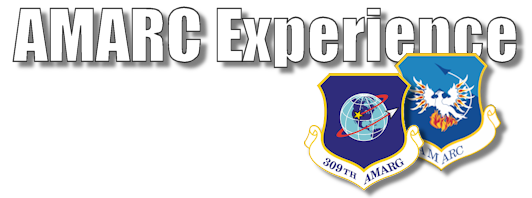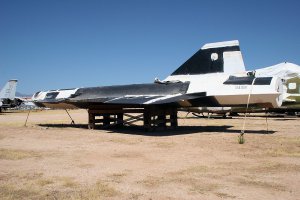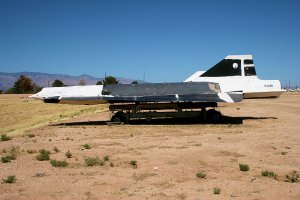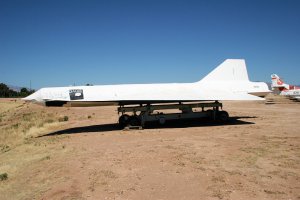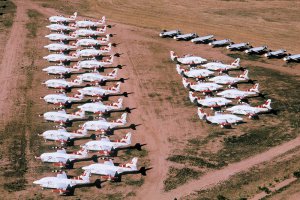One of the most interesting aircraft types to be stored at AMARC is the pilotless Lockheed D-21 Reconnainassance Drone. The D-21 is a stand-off high speed, high altitude reconnainassance drone that was the result of a 'Black' project, codenamed 'Tagboard', carried out by the famous Lockheed Skunk Works at Palmdale, CA.
The D-21 was powered by a Marquardt XRJ 43-MA20S-4 Ramjet engine, a modified version of the XRJ 43-MA20 engine which powered the Bomarc surface-to-air missile. The modifications were neccessary to ensure the engine would operate efficiently at the much lower pressures and higher temperatures that would be experienced while operating at speeds in excess of Mach 3 and altitudes of over 90,000 feet. The ramjet, by its design, can only start delivering thrust at a very high airspeed and as a result the D-21 required a delivery platform which would accelerate the aircraft to its operational velocity.
Lockheed converted two of their Mach 3+ capable A-12 Blackbird aircraft, serial numbers 60-6940 and 60-6941, to become D-21 motherships, these modified aircraft were designated M-21. The modifications allowed the D-21s to be carried 'piggyback' on top of the M-21 rear fuselage to designated launch points. Before launching the D-21 engine would be started to help accelerate the paired aircraft to the Mach 3 launch speed. After reaching the launch speed the D-21 fuel tanks would be topped off, the combination would seperate with the use of ballistic charges and the D-21 would continue its mission powered by its ramjet engine. On completion of its mission over a designated landmass and its return to 'friendly' airspace the D-21 would enter an unpowered descent. At 60,000 ft a hatch assembly was ejected and the drone's camera and exposed film would be jetisoned and recovered in mid-air by a Lockheed C-130 Hercules transport aircraft. Having no landing gear or other means of recovery, the D-21 would self destruct at 52,000 ft after completing its mission.
Lockheed D-21B Drone 531 being stored in the U.S. Air Force Museum storage area (Area 20). This aircraft was eventually scrapped in September 2013. © Phil Kovaric.
Lockheed D-21B Drone 536 in storage within Area 1. This aircraft was eventually scrapped in Septemer 2013. © Phil Kovaric.
Lockheed D-21B Drone 522 in storage within Area 1. This aircraft was eventually scrapped in Septemer 2013. © Phil Kovaric.
Row of Lockheed D-21B Drones (top right) in storage within Area 1, shortly after their arrival at AMARC. © Bob Shane.
The first flight of a D-21 took place during December 1964, the first actual launch of a D-21 took place on March 5, 1966, followed by two others on April 27, 1966 and June 16, 1966.
The fourth launch which took place on July 30, 1966 ended in disaster when D-21B #504 lost control after seperation and struck M-12 Blackbird 60-6941 resulting in both aircraft being destroyed. The two M-21 crewmen successfully ejected but unfortunately Launch Control Officer (LCO) Ray Torrick died while in the water of the Pacific Ocean awaiting rescue. This incident prompted the cancellation of the entire M-21/D-21 program.
In late 1966 a request was made by the Director of the National Reconnaissance Office (DRNO) to 'reorient' the drone program to be launched from B-52H motherships instead of the A-12. Approval was received and in January 1967 Contractor go ahead for the conversion of two B-52 aircraft and neccessary modifications to the remaining D-21 assets was issued. The programme was renamed to 'Senior Bowl'.
A 60 foot long, solid-propellant rocket booster (in essence a second stage) was manufactured by Lockheed which would be used to propell the D-21 to ramjet ignition speed after being gravity dropped from the B-52. All remaining D-21s were modified to support this new configuration and were re-designated D-21Bs. Two B-52Hs (61-0021 and 60-0036) were modified to carry the D-21Bs by adding pylons under each wing, electrical launch control systems and high-speed cameras to record the drone releases.
Between July 1967 and February 1968 all 15 remaining D-21 were upgraded to the D-21B standard by Lockheed at their Burbank, CA. facilities. In addition another 19 D-21B were manufactured taking the total number of available aircraft to 39;
| Serial Number | Conversion Date | Serial Number | Production Date | |
| 501 | July 1967 | 521 | March 1968 | |
| 507 | August 1967 | 522 | April 1968 | |
| 508 | August 1967 | 523 | May 1968 | |
| 509 | September 1967 | 524 | June 1968 | |
| 510 | September 1967 | 525 | July 1968 | |
| 511 | October 1967 | 526 | August 1968 | |
| 512 | October 1967 | 527 | September 1968 | |
| 513 | November 1967 | 528 | October 1968 | |
| 514 | November 1967 | 529 | November 1968 | |
| 515 | December 1967 | 530 | December 1968 | |
| 516 | December 1967 | 531 | December 1968 | |
| 517 | January 1968 | 532 | January 1969 | |
| 518 | January 1968 | 533 | February 1969 | |
| 519 | February 1968 | 534 | March 1969 | |
| 520 | February 1968 | 535 | March 1969 | |
| 536 | April 1969 | |||
| 537 | May 1969 | |||
| 538 | June 1969 | |||
| 539 | June 1969 |
During the the D-21's active service the following aircraft were expended during testing and operational launches;
| Serial Number | Expended | Location | Mission Notes |
| 507 | 06-NOV-1967 | Pacific Missile Range |
Launch and boost were successful. Drone attained mach Drone flew 134 nm. |
| 509 | 02-DEC-1967 | Pacific Missile Range |
Launch and boost were successful. Free flight continued on course for Drone flew 1,430 nm. |
| 508 | 19-JAN-1968 | Pacific Missile Range |
Launch and boost were successful. The drone travelled 550 miles down range, the the flight terminated prematurely when the drone began a pitch down and roll to the left. Telemetry was lost. Most probable cause of failure was electrical malfunction. The hatch was not recovered. Drone flew 280 nm. |
| 511 | 30-APR-1968 | Pacific Missile Range |
Launch and boost were successful. Following booster ejection, the drone was unable to sustain cruise and lost altitude and speed due to low thrust from the engine (inlet not started). Drone travelled 150 miles down range and was destroyed. Hatch not recovered. Drone flew 150 nm. |
| 512 | 16-JUN-1968 | Pacific Missile Range |
Successful test flight. The hatch was air-recovered by JC-130 aircraft. Drone flew 2,850 nm. |
| 514 | 01-JUL-1968 | Pacific Missile Range |
During pushover at the top of boost phase, the drone became laterally unstable due to insufficient autopilot gains. At separation, the booster struck the drone, rupturing the drone's fuel tank. The hatch ejected upon command and was recovered from the water in good condition. Drone flew 80 nm. |
| 516 | 28-AUG-1968 | Pacific Missile Range |
Launch and boost were successful. However, the drone's engine remained at minimum power and cruise altitude was not maintained. The hatch ejected at an excessive speed on descent and was not recovered. Drone flew 78 nm. |
| 515 | 15-DEC-1968 | Pacific Missile Range |
Successful test flight. This was the first mission to test the full system with the camera aboard. The hatch was air-recovered by JC-130. Drone flew 2,953 nm. |
| 518 | 11-FEB-1969 | Pacific Missile Range |
Launch and boost successful. Apparent shift in autopilot control at excessive mach caused the drone to descend resulting in the inlet remaining only partially started with attendant loss of thrust. Severe oscillations resulted. Drone believed to have structurally destroyed itself. Hatch was not recovered. Drone flew 161 nm. |
| 519 | 10-MAY-1969 | Pacific Missile Range |
Successful test flight. The hatch was air-recovered by JC-130 aircraft. Drone flew 2,972 nm. |
| 520 | 10-JUL-1969 | Pacific Missile Range |
Successful test flight. The hatch was air-recovered by JC-130 aircraft. Drone flew 2,937 nm. |
| 517 | 10-NOV-1969 | First Operational Mission |
Launch and boost successful. Computational errors in the drone's Inertial Navigation System prevented drone from flying the programmed route. Self-destruct believed to have occurred upon descent at [redacted] feet. Hatch was not recovered. |
| 521 | 20-FEB-1970 | Pacific Missile Range |
Successful test flight. [Redacted]. Changes to INS program validated. Hatch was air-recovered by JC-130 aircraft. Drone flew 2,969 nm. |
| 523 | 17-DEC-1970 |
Operational Mission South China |
The drone launched from the B-52 mother-ship on schedule at 17/0[?]04Z, and flew the programmed route over South China precisely as programmed. The recovery package ejected at the proper location on time at 17/0525Z. The C-130 recovery forces sighted the drone recovery package electronically and visually, and reported that the package was descending at a very high rate. Although in position above and below cloud cover, the recovery forces were unable to successfully catch the package as it passed through the clouds and impacted in the water. Initial indications are that the recovery package impacted with the water at a high rate, probably broke up and sank. The surface recovery ship in the projected recovery area did not sight the package, but will continue search operations jointly with the C-130 aircraft. Preliminary COMINT reflections indicate that the CHICOM air defense radars possibly tracked the drone during the most northern portion of its route for approximately 7 minutes, beginning 45 minutes after launch. Drone flew 2,448 nm. |
| 526 | 05-MAR-1971 |
Operational Mission South China |
Drone flew preset route over South China exactly as programmed. Recovery package ejection occurred on time at 05/0530Z and was sighted by the JC-130 recovery aircraft at 05/0531Z. Because of probable air pickup chute failure, aerial recovery was not possible and the package impacted in the water 10nm northwest of the predicted impact point at 05/0558Z. This malfunction differed from the failure on the previous mission in that the package apparently experienced a retarded if not soft landing, transmitted required telemetry signals, and floated for approximately one hour. The destroyer, USS McMorris, the back-up recovery ship, steamed to the splash down point and had visual sighting at 05/0700Z. Telemetry was lost at 05/0655Z and the destroyer reported loss of visual contact and unsuccessful boarding attempt as 05/0714Z due to extremely rough seas. The recovery destroyer remained in the impact area, however, the recovery package was assumed sunk in approximately 2100 fathoms of water. Drone flew 2,935 nm. |
In total four operational missions were carried out using D-21Bs over China to collect data from the Lop Nor nuclear test area, 2,000 miles from the China/Mongolia border. Due to various technical problems not a single mission resulted in the film being recovered, however three of the D-21s did complete their missions and return successfully only for the film to be lost due to parachute and recovery issues.
In 1971 diplomatic relations with China were improving and the Senior Bowl programme was cancelled by President Nixon.
Between July 1976 and January 1977 seventeen of the thirty eight D-21s built arrived for long term storage at AMARC. Since then many have left for display at various museums across the USA, however, two were transferred to NASA and are currently being stored at one of their facilities at Barstow, CA.
In the late 1990s a proposal was drafted to utilise three D-21s in NASA's possession as vechicles to test and develop a revolutionary DRACO (Demonstration of Rocket and Air-Breathing Combined-cycle Operation) engine. The plan was to use a B-52 as a launch platform, although a ground launch set-up was not ruled out and to develop a recovery system which would allow the D-21s to be re-used. Due to its original mission no low speed flight characteristic data availeble for the D-21 so any idea of multiple landing techniques would need to be proven before incorporated into the final design. When the three NASA D-21s were visually examined they were found to be in relatively good shape with the inlet and engine areas appearing to be clean and well preserved, although the composite leading edge elements had degraded from exposure. No details of the internal condition of the aircraft were noted and it was assumed that they may have been stripped of some parts.
It appears that the NASA proposal was not successful and that the three NASA D-21s are still in storage.
Specifications
General Specifications
| Construction | Titanium Alloy Beta-120 (Titanium - 13% Vanadium - 11% Chromium - 3% Aluminum) monococque airframe with some composite plastics |
| Powerplant | One Marquardt XRJ 43-MA20S-4 Ramjet engine, 1,500 lbs thrust. |
| Length | 42 ft 10 in |
| Wingspan | 19 ft 9 in |
| Height | 7 ft 1/4 in |
| Max. takeoff weight | 11,000 lbs |
| Crew | None |
Performance
| Maximum speed | Mach 4 (2,500+mph) at 80,000 to 95,000 ft |
| Range | 3,000 miles |
| Service ceiling | 95,000 ft |

